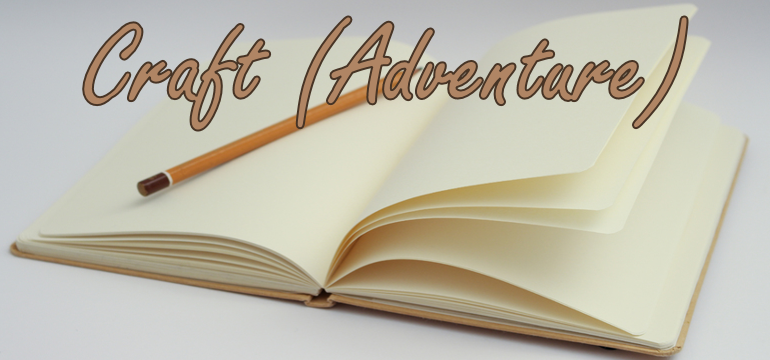The first step in any adventure writing is to come up with an idea. In a professional setting, you are occasionally lucky enough to have a developer who can provide an outline to spark your creativity. For home games, you’re usually challenged with fabricating the idea from whole cloth. I’m going to offer up a few suggestions that will point you in the right direction for finding an idea to build your adventure around.
Write the Game You Want to Play
You’re going to have the most creativity and passion for a project that you’re excited about; don’t write an adventure you don’t think will be fun to play. Find a theme, setting, and genre that spark your enthusiasm and write THAT game. If you’re really into crime dramas, areas with weird magic, and steam-punk, then maybe you should be writing about a serial killer who’s targeting dwarves in Alkenstar. When you craft that roleplaying scene where the PCs finally discover who the real killer is, it’s going to have a great impact because it’s the type of dramatic reveal that you’d want to experience as a player.
This concept is true for home and professional games. When you’re GMing for your friends, you can really tailor the game to what your group enjoys most about the game; use their excitement as your inspiration. For professionals, even if your developer hands you an outline that leaves you feeling unimaginative, take another look at it with the idea of “If I’m playing this, what sort of character would I want to have? What sorts of moments would I want the PC to experience in the adventure?” Answering these questions will inform you to the types of scenes and encounters you should be setting up.
Browse the Bestiaries
Physical copies of the Bestiary series are great for sitting back and flipping through just to look at the art and remind yourself of all the interesting things that already exist in the game world. If something catches your eye as interesting, jot down the name and page number. When you’re done, you’ll have a list of starting points for an adventure.
If a creature is too powerful, you can start the adventure with its minions that surround it, like starting with kobolds when a dragon inspires you. If a creature is too weak, consider ways to power it up. In Pathfinder you have advanced templates, mythic versions, and class levels to increase a creature’s power rating and make it fun and interesting. When the goblin hero decides to take back her swamp, she may lead a few troops of her fellow goblins to storm the nearby town. Even your 5th level adventurers might be challenged by these once insignificant foes.
Put a New Spin on an Old Trope
We’ve all heard of that same old story of the dragon who demands tribute and steals a wench from the nearby town. It’s tired; it’s been done. But if you put a spin on it, this idea becomes fresh and new again. Players might roll their eyes when their PCs hear rumors of a dragon snatching up young women and carrying them away to an island off the coast. You can pique their interest by telling them it’s been stealing from the general store, but only rope, tackle and other tools. Once they hear it’s a bronze dragon, they might stop and consider investigating.
Perhaps this bronze dragon has just learned to change shape into the form of a humanoid and wants to learn more about humanoid customs and traditions. She’s been kidnapping young women to learn about how to properly dress and act when the dragon visits town. Perhaps she wants to make new friends and thinks whisking them away is fine as long as she doesn’t hurt them. Add another twist: the dragon has been collecting the town’s supplies to help another nearby fishing village on the island whose stores were devastated by a bad storm. Throw in some marauding sahuagin and we’ve got a full adventure!
Ask Your Players
Perram hit on this during a Know Direction Beyond podcast: he recommended GMs look at their players skills to find out what kind of adventure they wanted to play. A character with maxed-out social skills wants to play a game with lots of role-playing and meeting interesting NPCs. A character with stealth, disable device, and bluff maxed out probably wants to play a heist. I recommend that writers use a similar tactic for their players.
For home games, this is straight forward. Ask the players what kind of game they want to play next or what sorts of characters they want to build. You’ll rarely get a unified voice, but you can often find enough threads of ideas and common themes to tie together into an interesting adventure.
In a professional setting, you can ask your customers. This can be as informal as a forum thread or more structured like an online poll. Since these are the people buying your products, finding out the types of adventures they want to buy from you can only help you in the long run.
Follow Up on Old Plots
Years ago, I was game master for a long-running home-brew campaign. The PCs had grown from 1st to about 13th level, and I had run out of ideas. I decided to just hang out with my gaming group that evening and chat about the game, what they liked about it and what they wanted to do next. Several players brought up questions about old villains who had escaped or allies that they’d made and then forgotten about. This got my brain crunching on all these lost plot threads and I decided to have several of the old allies host a banquet in honor of the PCs. The forgotten villains decided to crash the party. Before I knew it, these old plot threads had re-ignited the campaign.
Try out some of these tactics, get inspired, then start writing.






